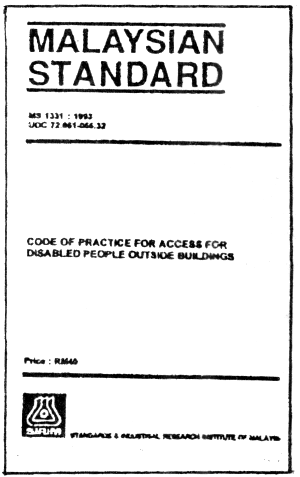|
无障碍的实践
四、
法律根据
马来西亚所设立的这项法规是根据一九九零年马来西亚标准工业研究协会(SIRIM)制定的《方便残障人出入公共场所的指南与规范》,这项法规的制订过程,参照了澳洲无障碍标准1428、英国残疾人无障碍建筑标准和实施规范(BS5810)和国际标准技术委员会出版的《方便残障人使用的建筑涉及指南》。
早在一九九零年九月二十日,第三十五届地方政府全国理事会(National
Council of Local Government)便针对一九七四年的道路、排水系统以及建筑规格附加法令(Uniform
Building By Laws)第三十四(A)项作出了修订,强制规定马来西亚国内所有建筑物,都必须提供残障人适用的设施,以便残障人士可以进出以及逗留在建筑物之中。有关法令一九九三年通过的修订法案规定了,所有这些建筑物与场所提供的便利与设施,必须符合马来西亚标准规格1184和1183的需要。法令也规定,所有新建筑物都必须按照这一标准,至于那些已经建峻的建筑物都必须按照这一标准,至于那些已经建峻的建筑物也一样必须赶上这一规格的规定,必须在有关条例实施后的三年内进行改建,以符合条文的需要。
根据上述法律的规定,有关法令的适用范围,划分得相当明确与广泛,包括了:
§
办公室、银行、邮局、商店、商场、百货公司以及其他各种行政与商业场所。
§
铁路、医药中心、诊疗所以及其他健康与福利场所。
§
餐厅、表演会堂、剧场、戏院、会议大楼、社区建筑、泳池、体育场所以及其他渡假、娱乐与休闲场所。
§
宗教场所。
§
学校、学院、大学、动物园、博物院、画廊、图书馆、展览场所及其他教育、文化及科研场所。
§
宿舍、酒店以及其他居住场所,单独家庭的私人住宅除外。
由上可见,有关法令的实施范围,几乎包括所有公共场所和工作空间。这一法令符合了残障人士争取在无障碍的环境之下活动的目标,也符合了为残障人士争取均等机会的目标。
根据国家宪法第九十五条A的精神,则确保了这一条修订后的法令,必将由所有马来西亚各州政府实施,并在各州的居住条规中落实。
|
STREET, DRAINAGE AND BUILDING ACT 1974
UNIFORM BUILDING (AMENDMENT) BYLAWS 1991
|
| Act 133 |
In exercise of the powers conferred by section 133 of
the Street, Drainage and Building Act 1974, the State Authority
makes the following By-laws:
|
| Citation |
1. These By-laws may be cited as the Uniform
Building (Amendment) By-laws (UBBL) 1991.
|
Amendment
to By-laws |
2. By laws 2 of the UBBL 1984, which in this By-laws is referred to us "the principal
By-laws" is amended by inserting immediately after interpretation "detached
building" the following interpretation.
"disabled persons means
people with a physical, hearing or sight impairment which affects
their mobility or their use of buildings as referred to under bylaw
34A."
|
| New By-law |
3. The principal By-laws is amended by inserting
immediately after by-law 34. The following new by-law 34A:
|
|
"Building
requirements for disabled persons." |
34A.
- Any building or part thereof to which this bylaw applies
shall-
a. be provide with access
to enable disable persons to get into, out of end within
the building except for any part of the building for which
access is provided wholly or mainly for the inspection,
maintenance or repair of the building, its services or
fixed plant or machinery; and
b. be design with facilities for used by
disabled persons.
- The requirements of this by-law shall be deemed to be
satisfied by compliance with Malaysian Standard MS 1184
and MS 1183.
- Buildings to which this by-law applies and which on the
date of commencement of this by-law have been erected, are
being plans have been submitted and approved shall be
modified or altered to comply with this by-laws within 3
years from the date of commencement of this by-law.
- Notwithstanding paragraph (3) the local authority may
where it is satisfied that it is justifiable to do so-
a. allow an extension or
further extensions of the period within which the
requirements of this by-law are to be complied with; or
b. allow variations, deviations or
exemptions as it may specify from any provisions of this
by-law.
- Any person aggrieved by the decision of the local
authority under paragraph (4) may within 30 days of the
receipt of the decision appeal in writing to the State
Authority, whose decisions shall be final.
- The requirements of this by-law shall apply to any of the
following buildings or any part thereof-
a. officers, banks, post
offices, shops, department stores, supermarkets and other
administrative and commercial buildings, except shophouses
existing at the commencement of this bylaw;
b. rail, road and air travel buildings
and associated concourses, car parking buildings and
factories;
c. hospitals, medical centres, clinics
and other health and welfare buildings;
d. restaurants, concert halts, theatres,
cinemas, conference buildings, community buildings,
swimming pools, sports buildings and other refreshment,
entertainment and recreation buildings;
e. Religious buildings;
f. Schools, colleges, universities,
zoos, museums, art galleries, libraries, exhibition
buildings and other educational, cultural and scientific
buildings; and
g. Hostels, hotels and other residential
buildings other than single family private dwelling
houses.
|

|
|
|
上一页
| 下一页
|
